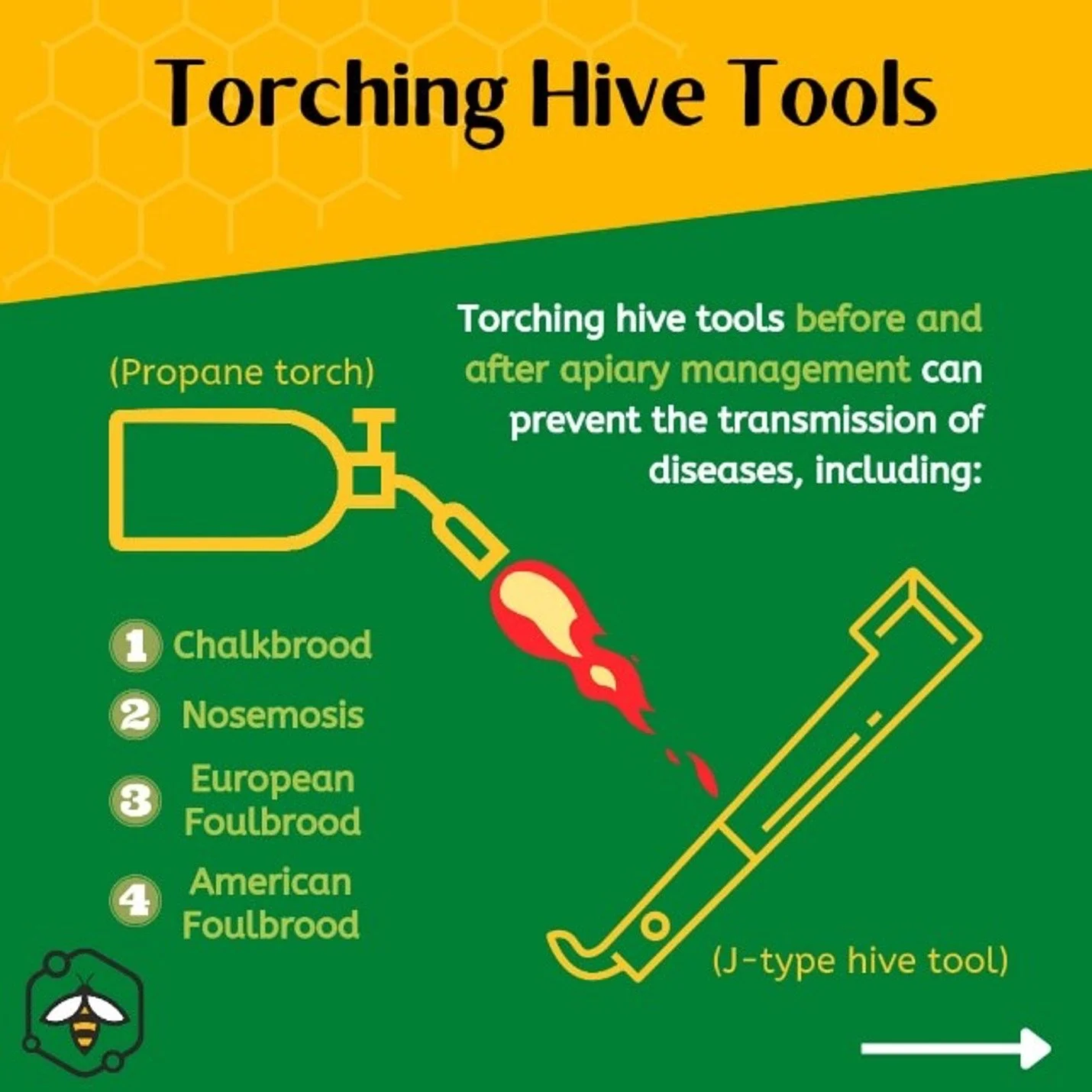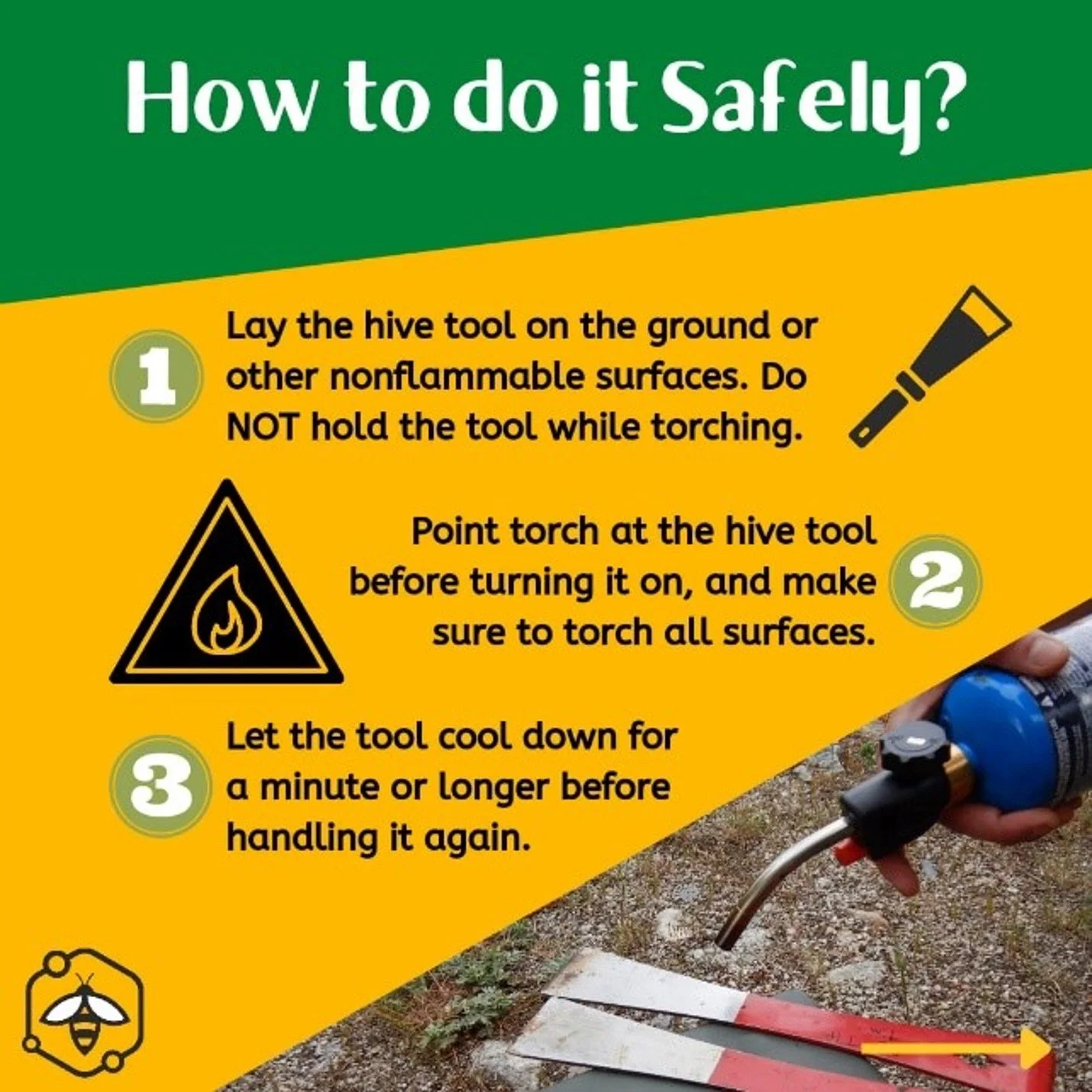BEST MANAGEMENT PRACTICES
& BIOSECURITY IN BEEKEEPING OPERATIONS
download PDF article here
Original article published in BeesCene, April 2023
By Nuria Morfin
Small or large, beekeepers need to manage their operation effectively and try to reduce stressors and risks that could affect the health and productivity of their honey bee colonies. Best Management Practices (BMP) and biosecurity practices (BP) provide recommendations to reduce the impact of pest and pathogens, reduce the negative effect of abiotic stressors (like agrochemicals), and provide guidelines for specific beekeeping practices (like pollination or overwintering). Here, we will provide a summary of BMP and BP relevant to the activities during the spring and early summer.
Equipment
The maintenance, sanitation, and replacement of beekeeping equipment is an important practice avoid the risks of contamination and transmission of diseases within and between operations.
Comb replacement. Remove 3- to 5-year-old frames from the brood chamber (or 20-30% of old frames from the operation each season). If there are no signs of reportable diseases (like American Foulbrood), the plastic foundations can be reused by scraping old combs and sanitizing the plastic (see below). Culling frames is an effective way to reduce the exposure of bees to agrochemicals and acaricides that can accumulate in the comb. Small amounts (or sublethal concentrations) of agrochemicals can be found in used comb, these small concentrations also have detrimental effects on bees exposed for long periods. Also, disposing of old combs reduces the presence and transmission of diseases, like Nosemosis, European Foulbrood, American Foulbrood, Sacbrood, and Chalkborod.
Sanitizing plastic foundation and plastic frames. To sanitize plastic frames, scrape the wax and propolis off the plastic foundation and/or frame using a putty knife, if possible, power wash the plastic foundation and/or frame. Next, soak the plastic foundation or frame using household bleach (sodium hypochlorite; NaClO) diluted in water for 30 minutes (250 ml of household bleach per 5 L of water). Rinse the plastic foundation and/or frame thoroughly before reusing it.
Note: Make sure to clean your workspace after disinfecting the frames to prevent the spread of pathogens, especially when using a pressure washer.
Torch your hive tool before and after inspecting a yard. Torching the hive tools before and after inspecting an apiary can prevent the transmission of diseases, like American Foulbrood, European Foulbrood, Nosemosis, and Chalkbrood. If possible, use a designated hive tool for each yard.
Ideally, avoid using leather gloves. Leather gloves can facilitate the transmission of diseases between colonies and yards. If you need gloves to handle the colonies, disinfect them periodically.
Disinfection of dead-out hives and frames. There are limited options to disinfect equipment, but regular disinfection is highly recommended to prevent disease transmission (Figure 2).
Purchase new or inspected equipment. Honey bee colonies and beekeeping equipment has to be inspected before transportation (i.e. sales, movement of bees between BC bee districts, and interprovincial movement). Inspections are required to avoid the introduction and spread of diseases. For more information contact your Apiary Inspector.
Setting and maintaining an apiary
Spring is a good time of the year to assess possible apiary sites. Avoid places that have high potential of flooding and that are humid or windy. Other considerations to select an apiary site include access to clean water and abundant forage sources. Once the apiary is set, it’s important to periodically maintain the hives and the yard, consider:
Using hive stands to keep the bottom boards off the ground to avoid humidity.
Clearing the yard of vegetation, including around he hives and hive entrances to facilitate air circulation and avoid the accumulation of moisture inside the hive.
Protecting the hives from wind. When necessary, use insulation to reduce heat.
Protecting the hives from predators and livestock. Electric fences are recommended in areas where livestock and wildlife are present.
Placing a maximum of 25-35 colonies per yard (or what is stated in the bylaws), being mindful of floral resources and other beekeepers in the area.
Having year-round vehicle access to the yards and enough room to work safely (and comfortably).
Following the bylaws that apply to your area (particularly for urban beekeeping).
Using sites that will not draw attention to the public to avoid vandalism or theft.
Colony inspections.
Regular inspections of the brood chamber are needed to assess the health of the colonies, including presence of pests and diseases and non-infectious conditions that could have detrimental effects on bee health.
Inspect for brood diseases, including Sacbrood (virus), Chalkbrood (fungi), European Foulbrood (bacteria), American Foulbrood (bacteria; reportable disease).
Monitor for varroa mites and consider using an Integrated Pest Management strategy to control mite levels (for more information visit our website, link below). Acaricide treatment should be applied when ≥3% varroa mites are found.
Identify signs of other diseases, like Nosemosis (microsporidian), Amoeba disease (protozoan), and viral diseases (like Chronic bee paralysis virus).
Identify potential pests, like wax moth and small hive beetle(Aethina Tumida is reportable pest).
Identify non-infectious conditions, like starvation, queenless colonies, and environmental stressors (e.g. humid environments).
Pesticide risk
Exposure to pesticides is always a risk to honey bees and other pollinators. To reduce pesticide exposure beekeepers can:
Get to know the local agricultural practices in the area and the agrochemicals used by surrounding farms.
Communicate with growers and farmers to assess the risk of agrochemicals on bees and other pollinators, and implement strategies to limit that risk.
Provide supplementary clean water to the colonies (in case natural water sources are contaminated or potentially contaminated with agrochemicals).
Remove colonies from pollination sites as soon as pollination is complete.
When colonies cannot be removed from the site of pesticide application, place a soaked cloth at the entrance of the hive to disrupt flight (no longer than 12 h).
There are no treatments for agrochemical exposure, but after the incident beekeepers can replace the queen if necessary, remove honey and pollen storage, transfer colonies to a clean hive with new frames and new foundation, and relocate the hives.
Incidents related to pesticide exposure could be reported to the Pest Management Regulatory Agency (PMRA)
To reduce the risk of agrochemical exposure, farmers can:
Communicate with beekeepers about their plans to use agrochemicals.
Avoid spraying flowering crops and avoid spraying during windy days.
Use proper equipment and deflector shields to help reduce pesticide exposure, in addition to following the instructions on the product label.
If possible, reduce or avoid the use of agrochemicals.
Treatments used in apiculture, like antibiotics and acaricides, can also present a health risk to honey bee colonies. Beekeepers should be mindful of this and implement BMP and IPM strategies to reduce the use of in-hive treatments, follow the manufacturer’s instructions and the recommendation of the Apiary Program.
For more information about IPM visit https://ttp-bchpa.ca/disease-and-pest-management/
Follow us on Instagram and Facebook <@bc_ttp and @BC Tech Transfer Program>
Share your thoughts with us using the #BCTTP
Acknowledgements. We thank Heather Higo and Heather Sosnowski for their valuable suggestions.
References
Applegate, J. R., & Kyle, B. (2021). Honey Bee Veterinary Medicine: A Developing Field. Veterinary Clinics: Food Animal Practice, 37(3), xiii-xiv.
Canadian Best Management Practices for Honey Bee health (nd) Available at https://www.ontariobee.com/sites/ontariobee.com/files/BMPmanua22920.pdf
Ministry of Agriculture and Food. Honey bee moving conditions & requirements (nd) Available at https://www2.gov.bc.ca/assets/gov/farming-natural-resources-and-industry/agriculture-and-seafood/animal-and-crops/animal-production/bee-assets/api_moving_conditions_04_15.pdf



